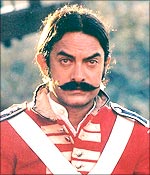|
|
| Help | |
| You are here: Rediff Home » India » Movies » Report |
|
 Aamir Khan in Mangal Pandey | ||
| |||||||||||||||||||||||
|
| |||||||||||||||||||||||
There was hardly any shot fired in the film. There were no bloodthirsty screams. No scenes of massacres. No visuals of rape and molestation. And yet, nearly three decades after it was released, Satyajit Ray's first Hindi language film Shatranj Ke Khilari remains arguably the best film about 1857.
Revisiting 1857: Satyajit Ray's vision
For it unfolds in the impending shadows of the brutal uprising. It is subtle, poignant and loaded with strong performances from its lead players Sanjeev Kumar, Amjad Khan, Shabana Azmi and Saeed Jaffrey. The film was not a hit in India but, in the United Kingdom and North America, it had a solid art-house run.
Set in Lucknow in 1856 and inspired by a story by writer Premchand, it revolved around two chess-obsessed noblemen, Mir (Jaffrey) and Mirza (Sanjeev Kumar) who meet every day to play chess. They are indifferent to the upheaval that surrounds them. At the same time, the King of Awadh (Amjad Khan), preoccupied with his creative pursuits, neglects his royal duties. The British exploit his weakness and demand that he abdicate.
Ray's use of chess as a metaphor for the cunning moves by the British to capture the king was lost on moviegoers in India, though the film ran only for four to five weeks in major cities. Unforgettable were the images of the king who, while flying kites, has one of his poems dissected by General Outram (Richard Attenborough), thus leading to the annexation of the kingdom.
 A year after the release of Shatranj Ke Khilari, another Hindi film, Junoon, produced by Shashi Kapoor and directed by Shyam Benegal, hit screens across the country.
A year after the release of Shatranj Ke Khilari, another Hindi film, Junoon, produced by Shashi Kapoor and directed by Shyam Benegal, hit screens across the country.
Revisiting 1857: Shyam Benegal's vision
Based on a story by Ruskin Bond, the film, which received mixed reviews, chronicles the period 1857 to 1858 when soldiers of the East India Company mutinied and many smaller kingdoms joined them in the hope of regaining their lands from the English. The movie is shown from the perspective of one of the leaders of the fight (Shashi Kapoor). Like Ray's film, Junoon was also a box-office failure.
Perhaps more flamboyant than the Ray classic, and more rousing than Junoon, was Mangal Pandey, The Rising, released two years ago.
Revisiting 1857: Ketan Mehta's vision
While some critics may accuse the filmmaker Ketan Mehta of taking liberties with history -- for one thing, the film doesn't doubt the story of cartridges greased with pork and beef fat -- the movie remained, for the most part, a powerful political adventure. Aamir Khan played Mangal Pandey, reportedly the first rebel to fire the shot that led to the uprisings in Meerut and elsewhere. The movie had a solid opening week in India, but plummeted in the second week, and proved to be a loser. It had a mediocre run abroad.
Unlike Ray's film, which ran for over two months in London drawing mostly British viewers (it also ran for about three months in New York and had a good run in many American cities), The Rising didn't become a crossover film abroad. History, it certainly seems, doesn't generate box-office victories in India.
While the books on 1857 and the subsequent years have been quite abundant in the West, there aren't too many movies dealing with the period.
Made in 1916, the American film Victoria Cross was based on the play by Paul Potter and had the 1857 uprising -- it was called the Sepoy Mutiny in the film -- as its backdrop. The film, hardly remembered today, centred on Ralph Seton (Lou Tellegen), a major in the English army who has sunk into a life of decadence in Kanpur. Sir Allan Strathallan (Ernest Joy) comes down to bring Seton the Victoria Cross, and is bringing his daughter Joan (Cleo Ridgley) -- Seton's sweetheart -- with him. Because of their arrival, Seton resolves to straighten out, but a rebel, Azimoolah (Sessue Hayakawa) uses Princess Adala (Mabel Van Buren) to ruin Seton's good intentions. Joan and her father catch Seton after a revel at the Palace and they see he is not the hero they believe him to be.
The film's attitude towards Indians was evident in the fact that most major Indian characters, who were nothing but caricatures, were played by white men or Eurasians.

|
|
| © 2007 Rediff.com India Limited. All Rights Reserved. Disclaimer | Feedback |